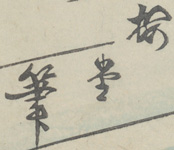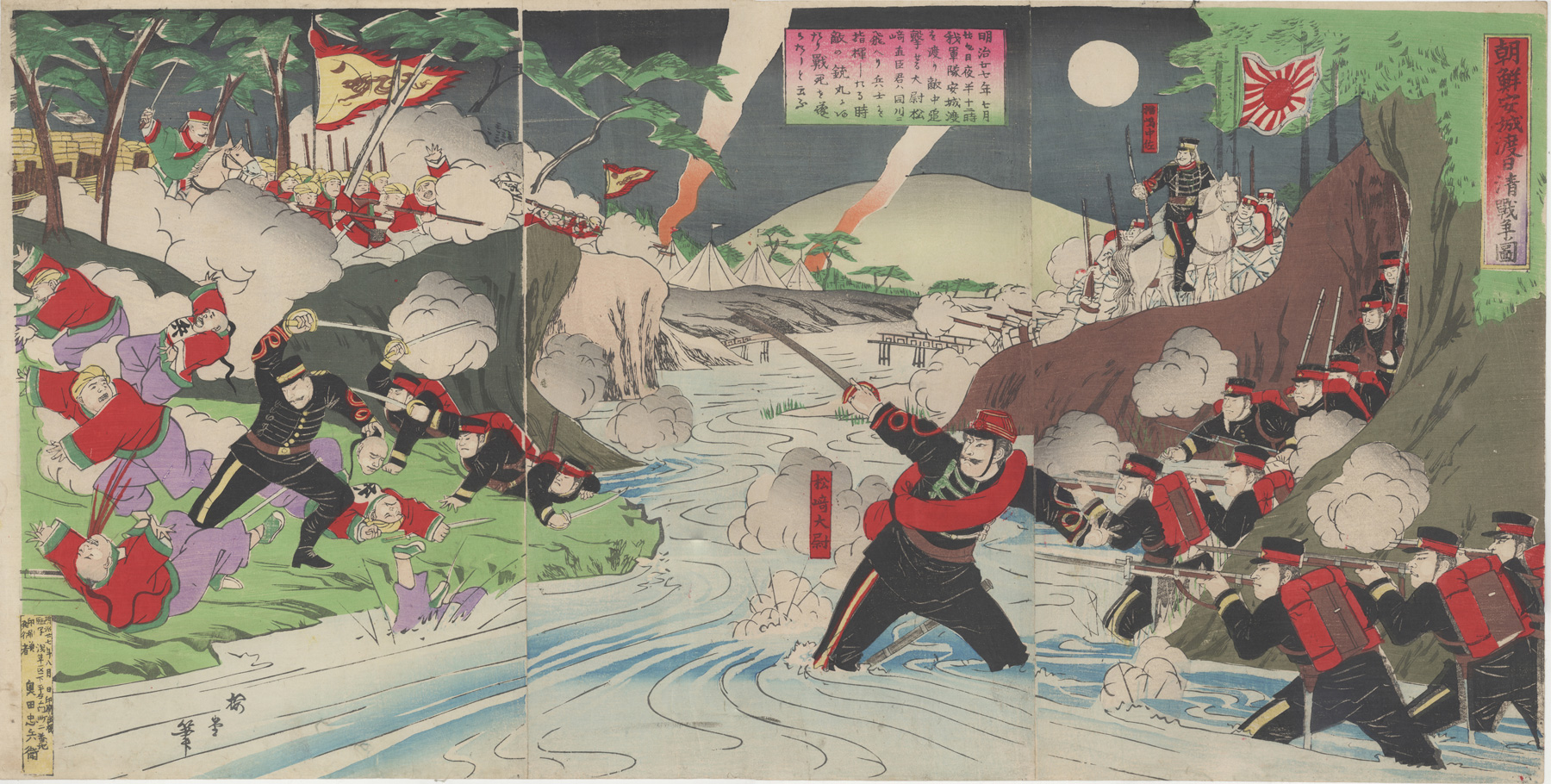The legendary Captain Matsuzaki (松崎大尉 in the small red cartouche), front and center with sword drawn, leads his men in the Advanced Column across the Ansong (Anjō in Japanese) attacking the enemy. The captain was felled by several bullets and died. Lieutenant Colonel Fukushima (福嶋中佐 in the small red cartouche) on his white horse with the attacks Left Wing.
For other depictions of Captain Matsuzaki's charge across the Anseong see The Great Battle of the Ansong Ford: The Valor of Captain Matsuzaki Crossing Anjō, Captain Matsuzaki Crossing the Anjō-sen and Captain Matsuzaki Fights Bravely in the Battle of Songhwan.
last revision:
The Battle
The large scroll in the print begins, "On the night of July 29th, 1894, at half-past twelve, our army crossed the Anseong."
The crossing of the Anseong was the beginning of the battle to take the Chinese stronghold of Songwhan, Korea. The attack started after midnight, as the relentless sun and heat argued for a night-time attack. As told in Heroic Japan, A History of the War Between China & Japan1, "Major-General Oshima divided his forces into two wings, the Right and Left. The Reserve force was to follow after the Left Wing, the Advance Column of which should start at midnight. At this hour, the little army was quietly roused and ordered to advance in utter silence. The night was a very still one, and so noiseless was the approach of the devoted troops that they might well have been taken for the shades of those Japanese warriors who, nearly three centuries before, had traversed in triumph this very road. But with what a difference! Then, clad in armor, carrying bows and quivers, and wielding trenchant blades; now, robed in the clothes of the once-despised West and bearing that most death-dealing invention of the century, the Murata rifle! Then, proceeding on a raid to satisfy merely the vain-glory of Hideyoshi ; now, to fight for the preservation of peace, the tranquillization of the Orient, and the salvation of Korea ! The Left Wing—in reality the Main Body— set out under the personal command of Major-General Oshima, followed by Lieut.-Colonel Fukushima Yasumasa, Major Nagaoka Gaishi and other officers. The troops were marched to the leftward of Sosachang, in order to get at the rear of the enemy’s flank. In this way they passed through the hostile line of pickets. The Right Wing, commanded by Lieut.-Colonel Taketa Shfizan, the Advance Column being formed by Captain Matsuzaki and his company, left the camp at Sosachang at 2 a. m. (July 29th). With the purpose of attacking the enemy in front, this body marched along the narrow road amidst the paddy-fields, and owing to the latter being submerged and the darkness of the night—not to speak of the ruts and broken places in the road it self—the advance was attended with great difficulty. The Advance Column made its way across the first and second bridges spanning the Ansong, while the men under Lieut.-Colonel Taketa crossed the first bridge at 3.05 a. m. As they then reached a place quite different from the hill (Mt. Chupalli) which had been selected as a land mark, the Lieut.-Colonel feared that the Advance Column had mistaken the road. At this moment the Column in question came into collision with the enemy at the village of Kehliuntong, about thirty metres distant from the Right Wing. Fierce and rapid firing being heard, the Lieut. Colonel dismounted and loudly called on his men to charge. The Advance Column was ordered by Captain Matsuzaki to spread out in open order, and the men were kept firing rapid flank volleys. Some troopers under Lieutenant Tokiyama were sent to attack the enemy’s rear, while other detachments were ordered to make a flank attack. After a little while of furious fighting the enemy sub-company under Lieutenant Tokiyama, which had been told to work around to the enemy’s rear by the river, got into difliculties. On attempting to ford the stream, they found the banks precipitous and the water deep, and the Lieutenant and a dozen or more of his men were drowned.
At 4.10 a. m. the enemy’s ranks were in utter confusion. They fled in the direction of the paddy-fields to the south and took the road to Songhwan. In the fight that took place here, Captain Matsuzaki, the leader of the Advance Column, was struck down. The village was thus at the mercy of the Japanese; there remained, however, the forts to be reckoned with. Leaving the village at 5.30 a. m., the Right Wing advanced along the narrow road amidst the paddy-fields, directing their course towards a hill on the right. Shortly after they reached a hill as high as that of Songhwan, and halted for a moment. Just at this time the right-hand forts of the Chinese were furiously attacked by the Japanese Left Wing. The square fort on the farthest west side did not offer much resistance and soon fell into the hands of the attackers, who there captured three cannon, a quantity of small-arms, plenty of ammunition, and more than ninety tents. Leaving their dead and wounded behind them, the Chinese fled precipitately in the direction of Asan."
The Japanese were to take the Songwhan forts later that day.
1 Heroic Japan: A History of the War Between China & Japan, F. Warrington Eastlake and Yamada Yoshi-aki, Sampson Low, Marston & Company, 1897, p. 17-18.
Print Details
| IHL Catalog | #1949 |
| Title (Description) | Illustration of The Sino-Japanese War, Anseong Crossing, Korea 朝鮮安城渡日清戦争ノ図 |
| Artist | Utagawa Kunimasa IV (1848-1920) |
| Signature |  Baidō hitsu |
| Seal | none |
| Publication Date | August 1894 (Meiji 27) 明治廿七年八月 |
| Publisher |  奥田忠兵衛 Okuda Chūbei (address in浅草区 Asakusa-ku) Marks reference: seal and publisher not shown. |
| Impression | excellent |
| Colors | excellent |
| Condition | good - three sheets joined; album backing; vertical fold center sheet |
| Genre | nishiki-e; senso-e |
| Miscellaneous | |
| Format | vertical oban triptych |
| H x W Paper | 14 1/4 x 28 1/2 in. (36.2 x 72.4 cm) |
| H x W Image | 14 x 28 1/4 in. (35.6 x 71.8 cm) |
| Literature | |
| Collections This Print |
11/20/2018


